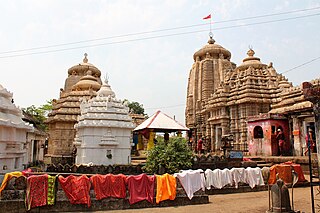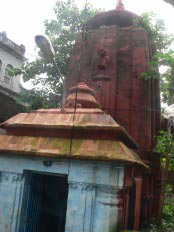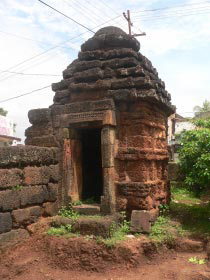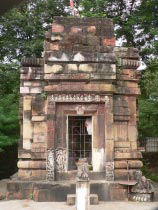
Kedareswar Temple, one of the eight Astasambhu Temples, is near the Mukteswar Temple, in Bhubaneswar, Odisha. The presiding deity is Shiva, referred to locally by the name ‘Kedareshwar’. It is in the precinct of Kedara-Gouri on the right side of the road leading to Puri from Bhubaneswar and at a distance of 40 metres south of Muktesvara. It is one of the ten monuments within the precinct. It is the main temple of the complex. The temple is facing south and the enshrined deity is a circular yonipitha made of sandstone. The linga at the centre is missing. The sanctum is 2.5 square meters which is 0.8 meters below the present ground. It stands near the yard of the Mukteswar Temple.

Rajarani Temple is an 11th-century Hindu temple located in Bhubaneswar, the capital city of Odisha, India.

Aisanyesvara Siva Temple is a 13th-century Hindu temple dedicated to Shiva located in Bhubaneswar, the capital of Odisha, India. The temple is in the precinct of Municipal Corporation Hospital, Sriram Nagar, Old Town, Bhubaneswar. It is close to the western compound wall of Lingaraj Temple. This is a living temple and with a shrine facing east.

Jalesvara Siva Temple Precinct is a Hindu Temple dedicated to Shiva situated on the southern outskirt of the village Kalarahanga at a distance of 2.00 km from Patia and 6.00 km south of Chudangagada in the northern outskirt of Bhubaneswar, Odisha, India. The presiding deity is a Siva-lingam within a circular yonipitha inside the sanctum, which is 1.15 meters below the chandrasila. The sanctum measures 2.00 square meters.

The Kapilesvara temple is a Hindu temple dedicated to Shiva located in the south western outskirt of the village Kapilesvara, Old Town, Bhubaneswar, Odisha, India. It is located at the end of Kapilesvara road leading from Lingaraj temple to Kapilesvara Village. The presiding deity is a Siva-lingam at the center of a circular yonipitha inside the sanctum. It is a living temple, facing towards east and maintained by Kapilesvara Temple Trust Board. The temple is situated within the precinct along with 33 other monuments. The precinct is located on the northern embankment of Manikarnika tank over an area of 44.00 square metres.

Lokanatha Siva Temple also Amunha Deula is an 11th-century AD temple in Bhubaneswar in the state of Odisha, India. It represents a proto type of Lingaraja in a miniature form. Lokanatha Siva temple is located in front of the Lingaraja temple in the south eastern corner across the road and adjacent to Lingaraja Temple Police Station in Old Town, Bhubaneswar. Until 1972 the temple was buried from all sides up to the bandhana portion, giving an impression as if the temple had no entrance. Hence people called it Amuha deula. In 1972 Debala Mitra conducted an excavation in front of the northern wall and exposed the entrance. The sanctum was empty. However, on the basis of the local traditions and the sculptural embellishment on the outer wall it was ascribed to Lord Siva. It is now known both as Lokanatha Siva and Amuha deula. People ascribe the temple to the Kesharis (Somavamsis). Except the entrance all other sides it is buried up to the bandhana.

Arjunesvara Siva Temple is a 12th Century A.D. temple in Bhubaneswar, in the state of Orissa, India. The temple is situated on the southern embankment of the Bindusagar tank at a distance of 70 metres and situated on the right side of the ratha road branching from the road leading from Lingaraja temple to Ramesvara temple. The temple is facing towards west.

The Bhringeswara Shiva temple is situated on the foothills of Dhauli and the left bank of the Daya River, in the southeastern outskirts of Bhubaneswar(India) in the village Khatuapada. The temple is facing towards west and the presiding deity is a circular yoni pitha with a hole at the centre. The temple is made of light grey sandstone. The temple is renovated one from bottom to the top by employing the earlier materials. This temple is now under the protection of Odisha State Archaeology.

Chintamaniswar Shiva Temple is a Hindu temple dedicated to Lord Shiva in Bhubaneswar, the capital of Odisha, India. It is at the end of the Chintamaniswar road branching from Cuttack-Puri road near the Old Station Bazar. The temple faces west and the enshrined deity is a Siva lingam with a yonipitha.

Purvesvara Siva Temple is located in Kancha Sahi, in the Old Town of Bhubaneswar,Orissa,India. It was built in 13th century AD. It is a living temple and now under the care of Purvesvara Temple Development Association.

Bhrukuteswar Shiva Temple is situated in Yamesvara Patna, Old Town, Bhubaneswar in Odisha, India. It is a single structure pidha deul without any frontal porch. According to the local people this temple was built by the Kesaris (Somavamsis).

The Somesvara Siva temple is located in the Kharakhia Baidyanath temple precinct in Kharakhia Vaidyanath Sahi, Old Town, of Bhubaneswar. It is located approximately 300 metres south of Lingaraja temple. Visitors may approach the site on the left side of Baidyanath Road leading from Lingaraja temple to Kapilesvar. It is a living temple and faces towards the west. The enshrined deity of this temple is a Siva lingam within a circular yonipitha at the center of the sanctuary located 0.93 metres below the chandrasila. The temple is under the care and maintenance of Babulal Makaddam Badu Mohapatra, the chief priest of the temple, on whose private land the temple stands.

The Tirthesvara Siva temple is a Hindu template located in Bhubaneswar, the capital of Odisha, India.

Mangalesvara Siva Temple is a Hindu temple located in Bhubaneswar, Orissa, India. It is located at Lat- 20◦ 14’ 38" N., Long- 85◦ 50’ 38" E., and at an elevation of 45 ft.

Papanasini Siva Temple is an abandoned Hindu temple located in Bhubaneswar, Orissa, India.

Manibhadresvara Temple – II is an abandoned Hindu temple located in Bhubaneswar, Orissa, India. Its elevation is 74 feet (23 m).

The Talesvara Siva temple is a Hindu temple in Bhubaneswar, Odisha, India.

Suka Temple is an abandoned and unused temple in Bhubaneswar, the capital of Odisha, India. The temple is devoted to saptaratha and the presence of female counterparts of the dikpalas in the upara jangha. This was built in the matured phase of temple building tradition of Odisha.

Bhimesvara Bisrama ghara is located in the Bhimesvara temple precinct in the Kapila Prasad, Housing Board Colony, Bhimatangi, Bhubaneswar. It is facing towards north. It has pyramidal superstructure.

Astasambhu Siva Temples is a collection of 8 Hindu temples dedicated to Lord Siva located in Bhubaneswar, the capital of Odisha, India.














